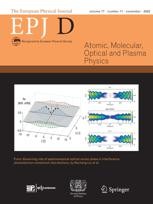Improving simulations of the PIII process
New simulation approach can better account for ion dynamics in the thin outer layer of plasma – offering a better understanding of the Plasma Immersion Ion Implantation process
New York | Heidelberg, 22 August 2025 Plasma Immersion Ion Implantation (PIII) is a surface treatment technique where a material is immersed in plasma, then subjected to high-voltage pulses. This accelerates ions from the plasma into the material surface, altering its properties and composition in a highly controlled way. PIII is now widely used to enhance the mechanical, physical, and electrical properties of materials ranging from semiconductors to biocompatible substances. So far, however, researchers have rarely considered how its performance can be affected by the evolving dynamics of ions in the plasma ‘sheath’: the thin layer near the plasma boundary, where electrons escape more readily than ions.
Plasma Immersion Ion Implantation (PIII) is a surface treatment technique where a material is immersed in plasma, then subjected to high-voltage pulses. This accelerates ions from the plasma into the material surface, altering its properties and composition in a highly controlled way. PIII is now widely used to enhance the mechanical, physical, and electrical properties of materials ranging from semiconductors to biocompatible substances. So far, however, researchers have rarely considered how its performance can be affected by the evolving dynamics of ions in the plasma ‘sheath’: the thin layer near the plasma boundary, where electrons escape more readily than ions.
Through new research published in EPJ D, Mohammadreza Sattari and Jalal Ghasemi at the University of Zanjan, Iran, present an improved approach to simulating ion dynamics within the sheath.
PIII already offers numerous advantages: safe and uniform treatment of surfaces, adaptability to many target sizes and materials, and easy integration with industrial processes. By better modelling sheath dynamics, the duo hopes researchers can enhance performance even further.
Within the sheath, ion motion is affected by a temperature-dependent viscosity, which introduces velocity gradients. These in turn create shear stresses – drag forces that alter how ions interact with the surface. Sattari and Ghasemi’s method approximates the sheath layer by solving magnetohydrodynamics equations that capture temperature-dependent viscosity effects. Accounting for shear stresses, they simulated how factors such as magnetic field intensity and angle, along with voltage pulse strength and timing, and background gas pressure influence sheath evolution at the target surface.
Their results show that when variations in ion velocities driven by temperature and viscosity are included, higher currents flow perpendicular to the normal target surface. At the same time, ion kinetic energy falls by more than 20% compared with simpler models – a finding with important implications for improving PIII performance.
Reference: Sattari, M., Ghasemi, J. Numerical simulation of the PIII process considering temperature-dependent thermophysical properties in a viscous sheath. Eur. Phys. J. D 79, 49 (2025). https://doi.org/10.1140/epjd/s10053-025-00989-w
Further Information
For more information visit: www.epj.org
Services for Journalists
The full-text article is available here.
Contact
Sabine Lehr | Springer | Physics Editorial Department
tel +49-6221-487-8336 | sabine.lehr@springer.com
